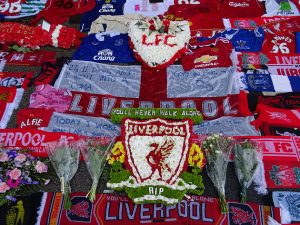Place and Prejudice: On Liverpool, Hillsborough and Territorial Stigma Ideas
Ideas, New in Ceasefire - Posted on Friday, November 3, 2017 17:41 - 0 Comments
By Alice Butler
 Kick-off was due at 3pm. By 3pm, lives had been lost and decisions made that would impact dozens of families, and one city, for years to come.
Kick-off was due at 3pm. By 3pm, lives had been lost and decisions made that would impact dozens of families, and one city, for years to come.
Earlier this week, on 1st November 2017, the Right Revered James Jones, a former Bishop of Liverpool, issued his report, titled The patronising disposition of unaccountable power, on the lessons of the Hillsborough disaster. In addition to setting out points of learning, he also acknowledges the role that negative stereotypes of Liverpool and Liverpudlians played in the long fight for justice. The release of this report serves as a timely reminder of the damaging effects of place-based stigma and stereotypes.
In this short piece, I consider the role that the ‘territorial stigmatization’ of Liverpool played in the aftermath of the Hillsborough disaster. The discussion throughout is illustrated with pictures taken at make-shift memorials in Liverpool three days after the findings from the Hillsborough Independent Panel ruled — after two years of deliberation — that the 96 Liverpool F.C. fans who died on 15th April 1989 were killed unlawfully.
‘Territorial stigmatization’ refers to a phenomenon first described by Loïc Wacquant in 1993, where he brought together Canadian-American sociologist Erving Goffman’s work on stigma and French sociologist Pierre Bourdieu’s work on symbolic violence and group-making. Since 1993, Wacquant and others have refined the concept to describe the structural dynamics inherent in places that are “widely labelled as ‘no-go areas’, fearsome redoubts rife with crime, lawlessness and moral degeneracy where only the rejects of society could bear to dwell”. For Wacquant, the concept is tied strongly to the post-industrial or post-Fordist society and its marginalised populations.
 Territorial stigmatization is separate from other types of stigma and is directed at spaces and places, imbuing these locations with a negative image. Often, the construction of such a negative image is aided by using existing stereotypes and stigmas such as racial or class stereotypes. The application of stereotypes to people living in a certain place, in turn, imbues that location with a negative image, which, as a result of stigma’s ‘stickiness’ latches on to the residents. Often, residents find that the adhesive nature of territorial stigma follows them even after they relocate; as Keene and Padilla illustrate.
Territorial stigmatization is separate from other types of stigma and is directed at spaces and places, imbuing these locations with a negative image. Often, the construction of such a negative image is aided by using existing stereotypes and stigmas such as racial or class stereotypes. The application of stereotypes to people living in a certain place, in turn, imbues that location with a negative image, which, as a result of stigma’s ‘stickiness’ latches on to the residents. Often, residents find that the adhesive nature of territorial stigma follows them even after they relocate; as Keene and Padilla illustrate.
When residents relocated from stigmatized neighbourhoods in Chicago to East Iowa, they continued to be stigmatized because of the popular perception of their place of origin.
 Liverpool is one of Britain’s major cities and has suffered greatly from stigmatization of its people and location. It has an image of social problems, of the stereotypical Scouser typified by Harry Enfield’s ‘calm down’ caricature, and of dereliction and depravity. The city was plunged into international infamy, following decades of decline, after the 1981 riots in Granby in the Liverpool 8 area of the city. Phil Scraton argues that the city’s portrayal was, in Lord Scarman’s investigation into the riots, tainted with notions of Liverpool’s “‘cultural deficiency’ and moral degeneracy” in explaining the city’s riots.
Liverpool is one of Britain’s major cities and has suffered greatly from stigmatization of its people and location. It has an image of social problems, of the stereotypical Scouser typified by Harry Enfield’s ‘calm down’ caricature, and of dereliction and depravity. The city was plunged into international infamy, following decades of decline, after the 1981 riots in Granby in the Liverpool 8 area of the city. Phil Scraton argues that the city’s portrayal was, in Lord Scarman’s investigation into the riots, tainted with notions of Liverpool’s “‘cultural deficiency’ and moral degeneracy” in explaining the city’s riots.
Indeed, following the three days of riots in 1981, the British Prime Minister Margaret Thatcher (1979-1990) considered implementing a “managed decline” of the city.
The Hillsborough disaster should have been remembered as a football disaster in which 96 children, parents, friends and relatives left home that morning, travelled to Sheffield to attend a football game, and never returned home. It should have been remembered as a sporting tragedy, an example of decisions made by police and by officials that resulted in the unlawful deaths of sports fans. It should have been remembered as a tragic moment in sporting history, and a dark day for Liverpool, its club and its people.
 It should not, however, have been a moment of immense media and legal stigmatization of the city. It should not have been a time when the city needed to fight for truth to emerge from the wreckage of the day.
It should not, however, have been a moment of immense media and legal stigmatization of the city. It should not have been a time when the city needed to fight for truth to emerge from the wreckage of the day.
After 27 years, 26th April 2016 marked the day that Liverpool fans, the families of the 96 victims, and the city, received word that the 96 died unlawfully. They had not — as the initial verdict and media coverage had claimed — died as the result of the behaviour of their fellow fans on that day.
 But why did so many among the British public not doubt that Liverpool fans could have been capable of — essentially, if accidentally, as the original verdict (revoked in 2012) had stated – killing their fellow fans? Why did the public not question the negative images proffered by the press? Why was The Sun’s headline coverage, which relied on ideas of moral degeneracy, not questioned? Did the public truly believe that Liverpool fans “urinated on the brave cops”? The Sun’s coverage was particularly bleak, suggesting that, in addition to sullying the police, fans picked the pockets of victims and attacked the police.
But why did so many among the British public not doubt that Liverpool fans could have been capable of — essentially, if accidentally, as the original verdict (revoked in 2012) had stated – killing their fellow fans? Why did the public not question the negative images proffered by the press? Why was The Sun’s headline coverage, which relied on ideas of moral degeneracy, not questioned? Did the public truly believe that Liverpool fans “urinated on the brave cops”? The Sun’s coverage was particularly bleak, suggesting that, in addition to sullying the police, fans picked the pockets of victims and attacked the police.
It all fit, somehow all too easily, into the popular image of Scousers and Liverpool. It matched the ‘calm down’ image, the view of a morally degenerate population living in a city that needed closing, one which was dangerous and deviant.
 Territorial stigmatization has long affected Liverpool. It was known for its poor public health in the 19th century, and was further tarred by stereotypes surrounding its cosmopolitanism, its large population of Catholics and Protestants, its immigrants, its distinctive accent, and its riots. Stigma is adhesive and can be difficult to remove. It builds on stereotypes, and we rely on stereotypes to work as building blocks to sort and process the world around us. In particular, reducing the world to these cognitive sorting mechanisms means that we can quickly and easily determine who is ‘us’ and who is ‘them’. We can filter-out who is part of our group and who is an ‘other’.
Territorial stigmatization has long affected Liverpool. It was known for its poor public health in the 19th century, and was further tarred by stereotypes surrounding its cosmopolitanism, its large population of Catholics and Protestants, its immigrants, its distinctive accent, and its riots. Stigma is adhesive and can be difficult to remove. It builds on stereotypes, and we rely on stereotypes to work as building blocks to sort and process the world around us. In particular, reducing the world to these cognitive sorting mechanisms means that we can quickly and easily determine who is ‘us’ and who is ‘them’. We can filter-out who is part of our group and who is an ‘other’.
It is thus precisely our reliance on stereotypical views of place that allowed Liverpool and its fans to be stigmatised in the popular imagination. Long stereotyped and caricatured in the media — including comedy, television dramas, and the press — when news of Hillsborough unfolded it became all too easy to rely on those images, those stereotypical building blocks to interpret the situation. It was easy to imagine a tracksuit-clad Scouser committing the horrific acts that media and police were suggesting. It was less easy to process the fact that Liverpool and Everton fans together showed dignity, grace and strength as they fought for justice for their city. That the fans were not responsible for their own demise simply did not fit into our stigmatized view of Liverpool.
And so, on 26th April 2016, when the verdict of ‘unlawful deaths’ was announced, this was a victory for bereaved families and the city. It was also a wake-up call for us all to think beyond stereotypes and to be aware of the damaging role territorial stigmatization places in our way of processing and understanding the world.



Leave a Reply